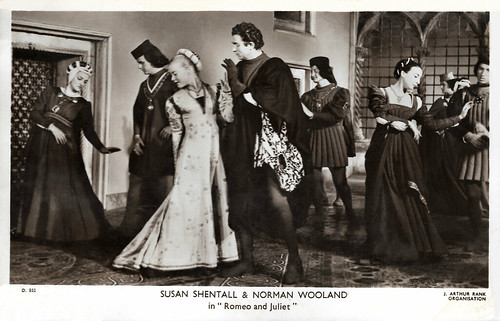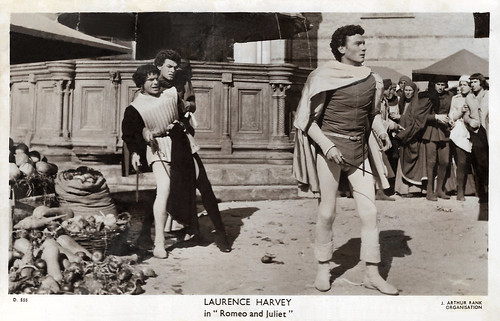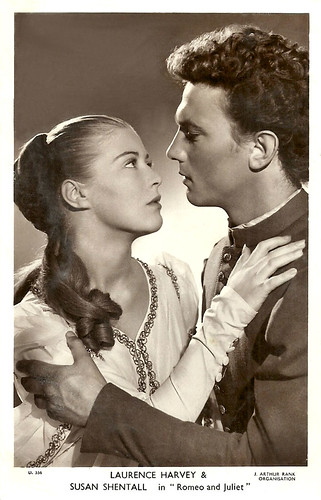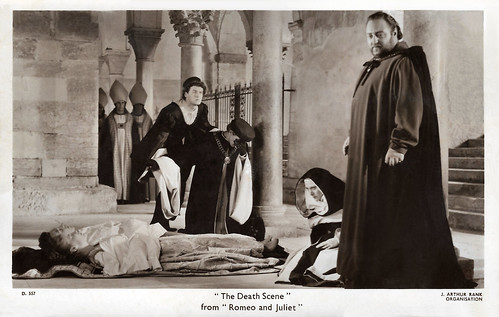The lavish British-Italian production Romeo and Juliet (Renato Castellani, 1954) is one of the many film adaptations of William Shakespeare's famous play of the same name. It stars Laurence Harvey as Romeo and Susan Shentall as Juliet. The film won the Golden Lion at the Venice Film Festival and several other awards.

British postcard in the Picturegoer Series, London, no. D 551. Photo: J. Arthur Rank Organisation. Publicity still for Romeo and Juliet (1954) with Laurence Harvey.

British postcard in the Picturegoer Series, London, no. D 552. Photo: J. Arthur Rank Organisation. Publicity still for Romeo and Juliet (1954) with Susan Shentall and Norman Wooland.

British postcard in the Picturegoer Series, London, no. D 554. Photo: J. Arthur Rank Organisation. Publicity still for Romeo and Juliet (1954).

British postcard in the Picturegoer Series, London, no. D 555. Photo: J. Arthur Rank Organisation. Publicity still for Romeo and Juliet (1954). Left stands the wounded Mercutio (Ubaldo Zollo) and right Laurence Harvey.
The Montagues and the Capulets are two families of Renaissance Italy. They have hated each other for years, but Romeo (Laurence Harvey), the son of one family and Julia (Susan Shentall), the daughter of the other, fall desperately in love. But the star-crossed lovers know that their families will never allow them to follow their hearts.
Renato Castellani's film adaptation of William Shakespeare's Romeo and Juliet (1954) has somehow fallen into a hole in film history. Despite a handsome production with some worthy performances, it is overshadowed by Franco Zeffirelli's Romeo and Juliet (1968) with Leonard Whiting and Olivia Hussey, and even the Hollywood version, Romeo and Juliet (George Cukor, 1936) with Norma Shearer and Leslie Howard.
However, it was the first version of the movie to be shot (or partially shot) on location in Italy in colour. While the leads are not the proper juveniles that appeared in the 1966 version, Laurence Harvey and Susan Shentall were closer to the ages of the characters than Howard and Shearer were.
In the cast are also Flora Robson as the Nurse, Mervyn Johns as Friar Laurence, Bill Travers as Benvolio, Sebastian Cabot as Lord Capulet, and John Gielgud as the Chorus (Gielgud would reprise the role in the 1978 BBC version). Other parts were played by inexperienced Italian actors: Mercutio was played by an architect, Montague by a gondolier from Venice, and the Prince by novelist Ennio Flaiano.
Castellani himself wrote the screen adaptation for his version. His film contains interpolated scenes intended to establish the class system and Catholicism of Renaissance Verona, and the nature of the feud. Exquisite is the cinematography by Robert Krasker, who was the cameraman for many historical super-productions.
The film won the Golden Lion at the Venice Film Festival, and was named the best foreign film by the US National Board of Review, which also named Castellani as best director. Commercially response to the film was underwhelming though.

British postcard in the Picturegoer Series, London, no. D 556. Photo: J. Arthur Rank Organisation. Laurence Harvey and Susan Shentall in Romeo and Juliet (1954).

British postcard in the Picturegoer Series, London, no. D 557. Photo: J. Arthur Rank Organisation. Publicity still for Romeo and Juliet (1954). Caption: The Death scene from Romeo and Juliet. Right: Sebastian Cabot as Capulet. Behind the bodies of Romeo and Juliet stands Bill Travers as Benvolio.

German postcard by Ufa, Berlin-Tempelhof, no. FK 1322. Photo: J. Arthur Rank Organisation. Publicity still for Romeo and Juliet (1954) with Laurence Harvey.
Sources: Wikipedia and IMDb.

British postcard in the Picturegoer Series, London, no. D 551. Photo: J. Arthur Rank Organisation. Publicity still for Romeo and Juliet (1954) with Laurence Harvey.

British postcard in the Picturegoer Series, London, no. D 552. Photo: J. Arthur Rank Organisation. Publicity still for Romeo and Juliet (1954) with Susan Shentall and Norman Wooland.

British postcard in the Picturegoer Series, London, no. D 554. Photo: J. Arthur Rank Organisation. Publicity still for Romeo and Juliet (1954).

British postcard in the Picturegoer Series, London, no. D 555. Photo: J. Arthur Rank Organisation. Publicity still for Romeo and Juliet (1954). Left stands the wounded Mercutio (Ubaldo Zollo) and right Laurence Harvey.
Fallen into a hole in film history
The Montagues and the Capulets are two families of Renaissance Italy. They have hated each other for years, but Romeo (Laurence Harvey), the son of one family and Julia (Susan Shentall), the daughter of the other, fall desperately in love. But the star-crossed lovers know that their families will never allow them to follow their hearts.
Renato Castellani's film adaptation of William Shakespeare's Romeo and Juliet (1954) has somehow fallen into a hole in film history. Despite a handsome production with some worthy performances, it is overshadowed by Franco Zeffirelli's Romeo and Juliet (1968) with Leonard Whiting and Olivia Hussey, and even the Hollywood version, Romeo and Juliet (George Cukor, 1936) with Norma Shearer and Leslie Howard.
However, it was the first version of the movie to be shot (or partially shot) on location in Italy in colour. While the leads are not the proper juveniles that appeared in the 1966 version, Laurence Harvey and Susan Shentall were closer to the ages of the characters than Howard and Shearer were.
In the cast are also Flora Robson as the Nurse, Mervyn Johns as Friar Laurence, Bill Travers as Benvolio, Sebastian Cabot as Lord Capulet, and John Gielgud as the Chorus (Gielgud would reprise the role in the 1978 BBC version). Other parts were played by inexperienced Italian actors: Mercutio was played by an architect, Montague by a gondolier from Venice, and the Prince by novelist Ennio Flaiano.
Castellani himself wrote the screen adaptation for his version. His film contains interpolated scenes intended to establish the class system and Catholicism of Renaissance Verona, and the nature of the feud. Exquisite is the cinematography by Robert Krasker, who was the cameraman for many historical super-productions.
The film won the Golden Lion at the Venice Film Festival, and was named the best foreign film by the US National Board of Review, which also named Castellani as best director. Commercially response to the film was underwhelming though.

British postcard in the Picturegoer Series, London, no. D 556. Photo: J. Arthur Rank Organisation. Laurence Harvey and Susan Shentall in Romeo and Juliet (1954).

British postcard in the Picturegoer Series, London, no. D 557. Photo: J. Arthur Rank Organisation. Publicity still for Romeo and Juliet (1954). Caption: The Death scene from Romeo and Juliet. Right: Sebastian Cabot as Capulet. Behind the bodies of Romeo and Juliet stands Bill Travers as Benvolio.

German postcard by Ufa, Berlin-Tempelhof, no. FK 1322. Photo: J. Arthur Rank Organisation. Publicity still for Romeo and Juliet (1954) with Laurence Harvey.
Sources: Wikipedia and IMDb.
No comments:
Post a Comment